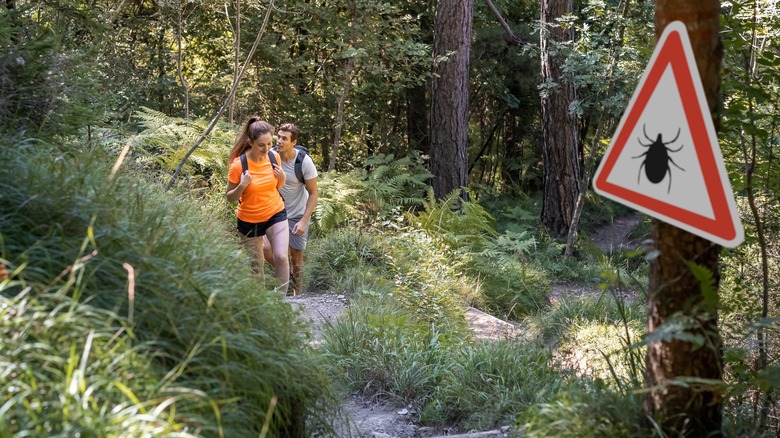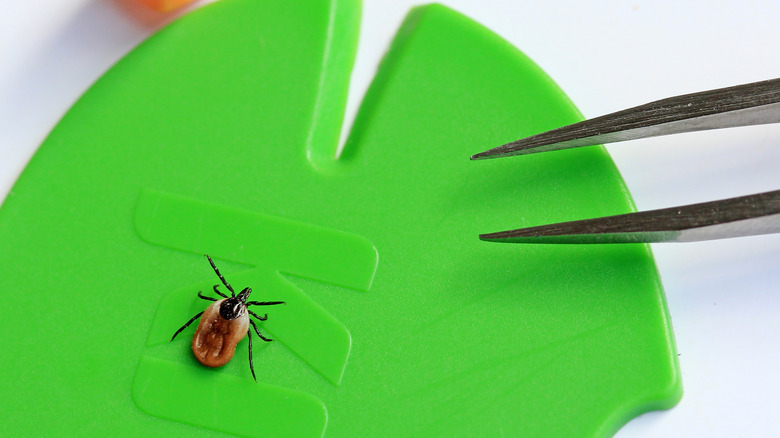Remove Ticks Quickly With This Unexpected Bathroom Staple
Your friends and you had a wonderful hike through a beautiful area. When you get home, you're surprised you didn't sustain even one mosquito bite. Unfortunately, you did manage to get a tick burrowed into your leg. This tiny biting bug is common in the U.S., and the Center for Disease Control and Prevention (CDC) notes they're most active during the warmer months from April to September. They're known to like grassy and wooded areas. When a tick finds a feeding spot — like your leg, for instance — it grasps onto the skin and cuts through the surface. They then burrow themselves in to feed, which can make removing them difficult, to say the least.
Fortunately, you can quickly remove them with a Q-tip by twirling it around the tick's body to tempt them to detach from the skin and attach itself to the cotton swab. The transition should happen relatively quickly, but it's worth trying for a few minutes. It's not the recommended method by the CDC, but it does work to get some ticks out of your skin painlessly.
The cotton swab method doesn't always work, though, so it's essential to know how to remove them with tweezers, as well as what to do afterwards (and how to prevent tick bites in the first place).
Recommended method for removing a tick
When the cotton swab method works, you save pain and hassle, but it's not guaranteed to work all the time. And since you'll want to remove any ticks from your body within 36 hours, there's a CDC-recommended way you can try to safely remove a tick.
Grab some pointed tweezers and get as close to the skin's surface and the tick's body as possible. Grasp onto the tick and pull up firmly. A tick can embed itself firmly into the skin, so you must commit when you pull it out. Grip the tweezers firmly to ensure they don't slip off the tick's body. The quicker you remove the tick, the faster the ordeal will end. If any parts of the tick are left on your skin, try to remove them with the tweezers; otherwise, just leave them in and let the skin heal.
The battle doesn't end with getting the tick out, though. It's essential to clean and disinfect the area with soap or rubbing alcohol to ensure that germs don't get into the wound. The CDC also recommends disposing of live ticks in alcohol, bagging them up, or flushing them down the toilet. Don't crush them.
Aftercare and prevention of tick bites
Ticks carry dangerous diseases like Lyme disease, Rocky Mountain Spotted Fever, and babesiosis. Thus, it's ideal to make an appointment with your healthcare provider to have your bite checked. In some instances, medication might be given out to lower the risk of tick-borne diseases, but most of the time, you'll simply have to wait it out. Watch for symptoms to appear within the first 30 days, like a bullseye rash around the bite site. The CDC also advises talking to a medical specialist if you experience fever, fatigue, headache, joint swelling, or muscle pain.
The best medicine for tick bites is to prevent them altogether. A tick has to have skin to attach to, so when hiking, wear long sleeves and pants and tuck your pants into your socks to keep ticks from biting you. NIH MedlinePlus Magazine also recommends wearing light clothes so you can see ticks and easily brush them off. Using a tick repellant is also beneficial when you know you'll be venturing into an area where ticks live during the prime season.
Since ticks like to find areas in your body that aren't covered by clothes or protected by repellant, check your body when you leave a tick-infested area. Look for places with folds, like in between your toes and the crease of your legs. You'll also want to run a fine-tooth comb over your scalp to check that area.



